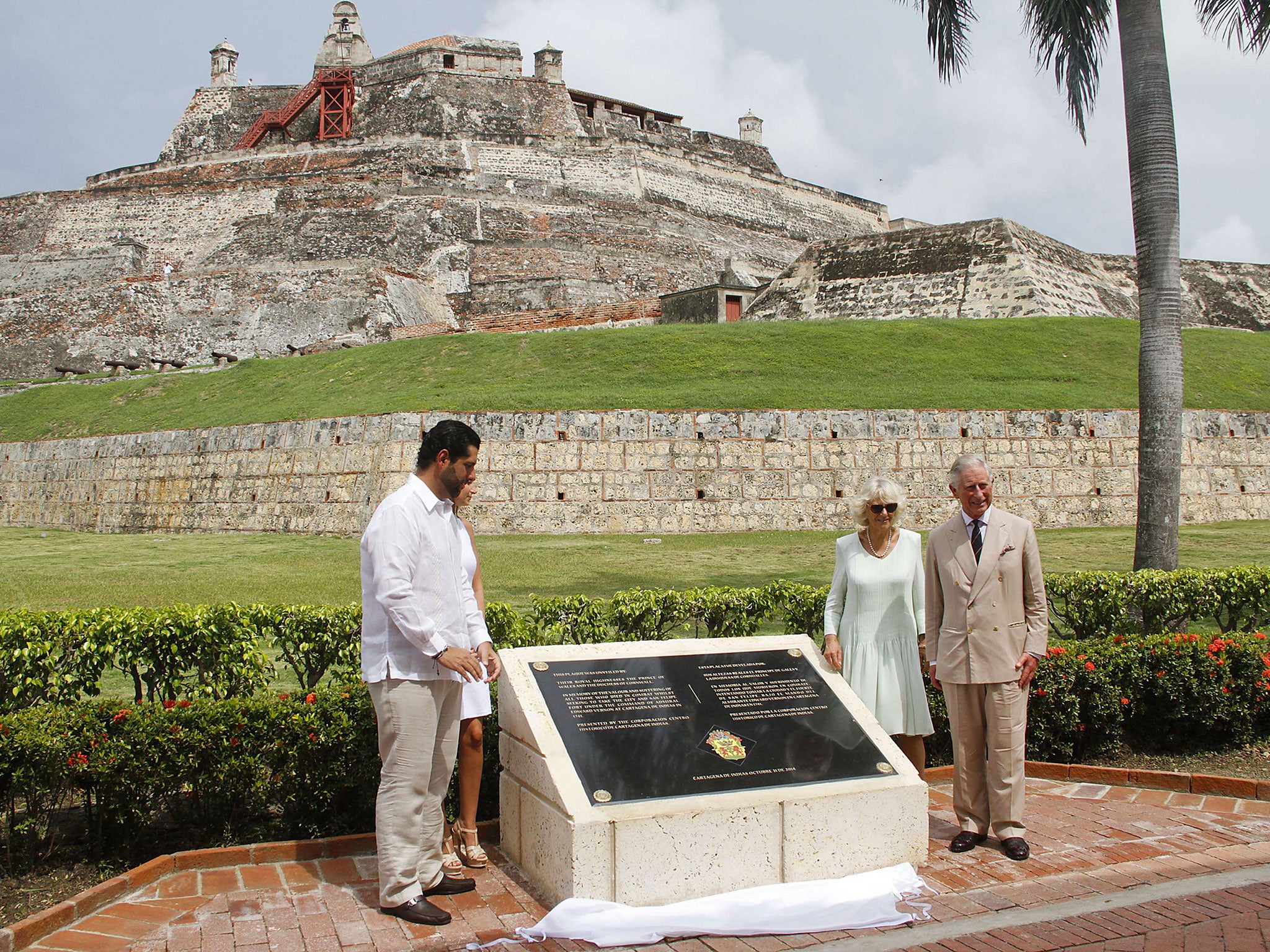Prince Charles caught in Columbian row as he unveils memorial to ill-fated British attack
Residents of Cartagena up in arms over colonialist commemoration

When Prince Charles unveiled a plaque commemorating one of Britain’s most ill-fated colonial ventures, the intention was to mark the suffering on all sides as well as attract a few more tourists to the Colombian city of Cartagena.
Unfortunately, some of the residents of the coastal resort have not quite seen it that way, and have taken exception to the marble monument glorifying 18th century “English pirates” to the extent that they are calling for it to be taken down.
Britain sent a vast naval fleet consisting of nearly 200 vessels and up to 30,000 military personnel to claim Cartagena in 1741, as part of an ill-starred attempt to seize control of key Spanish ports dominating access to the Caribbean and Latin America.
The resulting siege was a disaster for the British, resulting in the loss of 18,000 men to death or disease, including militia recruited from the then American colonies, and the effective end of any ambitions in London to extend the Crown’s list of imperial possessions to South America.
King George II was so embarrassed by the defeat that he ordered all mention of the campaign to be removed from newspapers and the destruction of hundreds of prematurely cast victory medals.
But efforts by Cartagena's mayor to draw a line under this ignominious episode, which also resulted in loss of nearly 2,000 Spanish casualties, and attract British tourists from cruise ships calling at the port are threatening to backfire.
In pictures: Prince Charles's most controversial moments
Show all 10Since the unveiling of the plaque by Prince Charles and the Duchess of Cornwall at a low key event last week, complaints have been made that it was built without consultation and honours little more than the murderous intent of British colonialists.
Hernando Marrugo, a tourist guide in Cartagena, which is a UNESCO World Heritage site, said: “The mayor has a nerve to commemorate the deaths of 10,000 English troops. These men intended taking Cartagena and massacring our ancestors. It makes me feel bad showing the plaque to the tourists.”
A local historian has called for residents to take the matter into their own hands, citing a previous example where a statue of a city hero widely considered inappropriate was taken down.
Sergio Lozano told local paper El Heraldo: “I believe the same thing will happen - the community took it upon themselves to remove the statue in order to remain faithful to the town’s history. The community is responsible for removing the plaque.”
Opponents of the plaque, who also took to social media to voice their discontent, pointed out that it was placed within metres of a statue to Admiral Don Blas de Lezo, the wily Spanish commander who is credited with seeing off the British challenge.
But supporters insisted the monument and the ceremony to mark its unveiling was intended to recognise the suffering on all sides in the three-month siege, which was part of a wider Caribbean campaign known as the War of Jenkin’s Ear - named after a British captain whose ear was apparently severed by a Spanish sailor and provided London with the excuse to open hostilities.
In a statement, the Corporation for the Historical Centre of Cartagena said: “The Prince and the Duchess expressed their condolences to the people of Cartagena, the Spanish, the British and the militia from the American colonies who lost their lives to the war.”
Clarence House declined to comment on the row, but the Colombian authorities said plans were in place for further monuments to mark the events of nearly 300 years ago.
Sabas Pretelt de la Vega, a member of the corporation, said: “We’ve made many tributes to the fallen of the city of Cartagena, and will continue to make them in the future. We seek a new chapter in the history of Cartagena.”
What was the War of Jenkin’s Ear?
The siege of Cartagena was part of a wider Anglo-Spanish 18th Century conflict known as the War of Jenkin’s Ear.
Named after a captain whose ear was severed by a Spanish sailor and then paraded in a pickle jar before a bellicose Parliament, the clash was intended to allow Britain to seize control of the Caribbean.
On paper, the odds were overwhelmingly in British favour as a fleet of 186 ships conveying an invasion force of 12,000 men arrived off the Colombian coast in 1741 opposed by just 3,000 Spaniards.
But a mixture of incompetence, illness and brilliant defence by the leader of the Spanish defence, Admiral Blas de Lezo, saw the British thrown back into the sea with huge losses.
Thousands of “victory” medals, including one which depicted the British Admiral Edward Vernon looking down on his kneeling Spanish opponent, were hurriedly recalled.
Subscribe to Independent Premium to bookmark this article
Want to bookmark your favourite articles and stories to read or reference later? Start your Independent Premium subscription today.

Join our commenting forum
Join thought-provoking conversations, follow other Independent readers and see their replies